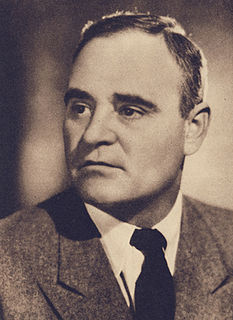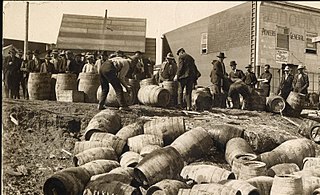A referendum on introduction prohibition was held in Norway on 5 and 6 October 1919. Partial prohibition had been in effect since 1917, and the prohibition proposal did not include all types of alcohol, only spirits. The proposal was approved by 61.6% of voters. A second referendum on whether the prohibition should be maintained was held in 1926, resulting in an overturning of the law.

A constitutional referendum was held in France on 13 October 1946. Voters were asked whether they approved of a new constitution proposed by the Constituent Assembly elected in June. Unlike the May referendum, which saw a previous constitutional proposal rejected, the new constitution was accepted by 53.2% of voters, and brought the French Fourth Republic into existence. Voter turnout was 67.6%.

A prohibition referendum was held in Iceland on 10 September 1908, alongside parliamentary elections. In the first referendum to be held in the country, voters were asked whether they approved of a ban on importing alcohol. It was approved by 60.1% of voters. The ban was overturned by a second referendum in 1933.

A prohibition referendum was held in Iceland on 21 October 1933. Voters were asked whether they approved of the ban on importing alcohol imposed following a 1908 referendum being lifted. It was approved by 57.7% of voters.

Parliamentary elections were held in Hungary between 8 and 15 December 1926. The result was a victory for the Unity Party, which won 161 of the 245 seats in Parliament. István Bethlen remained Prime Minister.

Parliamentary elections were held in Hungary between 31 March and 7 April 1935. The result was a victory for the Party of National Unity, which won 164 of the 245 seats in Parliament. Gyula Gömbös remained Prime Minister.

Parliamentary elections were held in Hungary on 28 and 29 May 1939. The result was a victory for the Party of Hungarian Life, which won 181 of the 260 seats in Parliament. Pál Teleki remained Prime Minister. It won 72 percent of the parliament's seats and won 49 percent of the popular vote in the election. This was a major breakthrough for the far-right in Hungary.

General elections were held in Italy on 29 October 1882, with a second round of voting on 5 November. The "ministerial" left-wing bloc emerged as the largest in Parliament, winning 289 of the 508 seats.

Parliamentary elections were held in Latvia on 7 and 8 October 1922. The Latvian Social Democratic Workers' Party remained the largest party, winning 30 of the 100 seats.

General elections were held in Liechtenstein on 29 April 1945. Following the "silent elections" of 1939, they were the first to use the new proportional representation system. The Progressive Citizens' Party won eight of the 15 seats in the Landtag, but remained in coalition with the Patriotic Union.

General elections were held in Romania in June 1939. The Chamber of Deputies was elected on 1 June, whilst the Senate was elected a day later. They were the first since the introduction of the royal dictatorship of King Carol II under the 1938 constitution. Voters were presented with a single list from the National Renaissance Front, which had been the only legally permitted party in Romania since December.

Parliamentary elections were held in Romania on 5 March 1961. Voters were presented with a single list from the People's Democratic Front, which was dominated by the Romanian Workers Party. The Front won all 465 seats in the Great National Assembly.

A referendum on the electoral law was held in San Marino on 22 September 1996. Voters were asked four questions on changes to the electoral law and electoral system, all of which were approved by voters.
Two referendums were held in Switzerland in 1887. The first was held on 15 May, asking voters whether they approved of a federal law on spirits, and was approved by 65.9% of voters. The second was held on 10 July, asking voters whether they approved of an amendment made to article 64 of the federal constitution, and was approved by 77.9% of voters and 20.5 cantons.
A referendum on a war tax was held in Switzerland on 6 June 1915. Voters were asked whether they approved of amending the constitution to introduce a one-off war tax. It was approved by a large majority of voters and all cantons, the first time a referendum had been passed in every canton.
A referendum on the armed forces was held in Switzerland on 3 November 1907. Voters were asked whether they approved of the organisation of the federal armed forces. The proposal was approved by 55.2% of voters.
A referendum on employment protection was held in Switzerland on 17 February 1924. Voters were asked whether they approved of an amendment to the federal employment protection law. The proposal was rejected by 57.6% of voters.
A referendum on the sugar industry was held in Switzerland on 14 March 1948. Voters were asked whether they approved of a federal resolution on the reorganisation of the Swiss sugar industry. The proposal was rejected by 63.8% of voters.
Two referendums were held in Switzerland during 1918. The first was held on 2 June on introducing a direct federal tax, and was rejected by a majority of voters and cantons. The second was held on 13 October 1918 on introducing proportional representation for National Council elections, and was approved by a majority of voters and cantons. As a result, proportional representation was introduced in the 1919 elections.
Five referendums were held in Switzerland in 1970. The first was held on 1 February on a federal resolution on the domestic sugar market, and was approved by voters. The second was held on 7 June on a popular initiative "against foreign infiltration", and was rejected by voters. The third and fourth were held on 27 September on an amendment to the Swiss Federal Constitution regarding promoting gymnastics and sports, which was approved, and a popular initiative on the "right to habitation and expansion of family protection", which was rejected. The fifth was held on 15 November on an amendment to the federal financial order, and was approved by voters.













